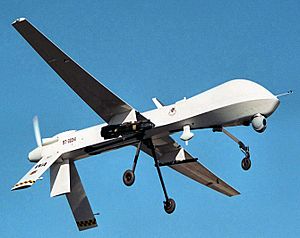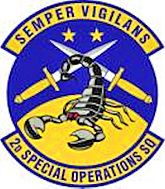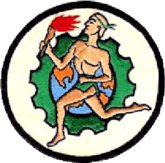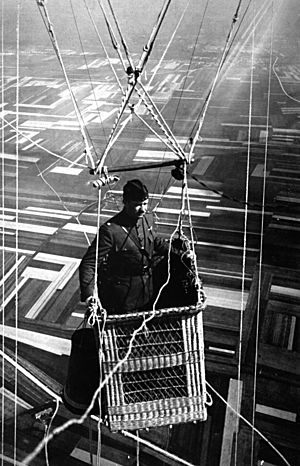2nd Special Operations Squadron facts for kids
The 2nd Special Operations Squadron is a special unit in the United States Air Force Reserve. It's part of the 919th Operations Group and is based at Hurlburt Field, Florida. This unit flies special aircraft called Reaper drones, which are controlled from far away.
This squadron is one of the oldest units in the U.S. Air Force. It started way back on September 25, 1917. During World War I, it was the very first American air unit to fight an enemy on foreign land. They used observation balloons to help soldiers on the ground.
After World War I, the unit trained with balloons. Later, during the Cold War, it helped the Strategic Air Command by moving important equipment and people. Today, it continues its important work with modern technology.
Quick facts for kids 2nd Special Operations Squadron |
|
|---|---|

A Predator drone like those flown by the squadron.
|
|
| Active | 1917–1922; 1930–1942; 1949–1961; 2009–present |
| Country | |
| Branch | |
| Role | Special Operations |
| Part of | Air Force Reserve Command |
| Garrison/HQ | Hurlburt Field, Florida |
| Engagements | World War I
Occupation of the Rhineland |
| Insignia | |
| Emblem of the 2nd Special Operations Squadron |  |
| Patch with 2nd Strategic Support Squadron emblem (approved 26 February 1951) |  |
Contents
History of the Squadron
World War I: Balloon Observers
The unit started as Company B, 2nd Balloon Squadron on September 25, 1917. This happened at Fort Omaha, Nebraska. Their job was to use balloons to watch for enemy movements and help artillery units aim their shots.
Training was tough due to bad weather. So, the Army decided to move balloon schools to warmer places. On December 7, 1917, the unit, now called the 2nd Balloon Company, traveled to Saint John, New Brunswick, Canada. From there, they sailed across the Atlantic Ocean. They arrived in England on Christmas Day and then went to France.
They reached the American Expeditionary Force Balloon School in France on January 3, 1918. Here, they learned to use French observation balloons. On March 1, they moved to Toul, France, joining the First United States Army. This made them the first American balloon company to reach the Western Front and enter combat.
Their missions were dangerous. On March 16, Lieutenant Sidney Howell had to jump from his burning balloon after enemy planes attacked it. He was safe and received a special medal. The company moved often as the front lines changed. Their balloons were often attacked, but observers usually landed safely.
The 2nd Balloon Company took part in major battles like St. Mihiel and Muse-Argonne. They made 180 balloon flights with 13 observers. Nine of their balloons were shot down, but no squadron members were killed or hurt in action.
After the war ended on November 11, 1918, the company moved to Germany. They helped with occupation duties along the Rhine River. In May 1919, they were ordered back to the United States. They arrived in New York on June 22, 1919, and the soldiers went back to civilian life.
Between the World Wars
After the war, the company moved to Ross Field, California. On October 1, 1921, it became the Balloon School Detachment. However, strong winds made it hard to train there. So, the unit was closed down on May 21, 1922.
A new 2nd Balloon Company was formed on May 29, 1930, at Fort Bragg, North Carolina. They used different types of observation balloons. On October 1, 1933, the unit was renamed the 2nd Balloon Squadron.
By 1940, airplanes were becoming better for scouting. This made observation balloons less useful. The squadron continued to train until it was officially closed on February 3, 1942, shortly after the attack on Pearl Harbor.
Cold War Support Missions
During the Cold War, the Air Force needed ways to move important equipment. So, the 2nd Strategic Support Squadron was started on January 14, 1949. They were based at Biggs Air Force Base, Texas.
They first flew C-54 Skymaster planes. These planes carried secret equipment and people all over the world. In the 1950s, they upgraded to larger C-124 Globemaster II planes. The squadron was closed on June 15, 1961, when other units took over their transport missions.
Modern Drone Operations
The squadron was brought back to life as the 2nd Special Operations Squadron in 2009. Because of its history as a scouting unit, it was given modern Predator drones. These are aircraft controlled by pilots on the ground.
The 2nd Special Operations Squadron became the first Air Force Reserve unit to control a drone combat patrol. This means they flew drones 24/7 over important combat areas.
The squadron was first based at Nellis Air Force Base, Nevada. This was far from its main unit in Florida. All the drones they flew were owned by active-duty units and were used in combat zones. In 2014, the squadron moved to its current home at Hurlburt Field, Florida. At the same time, they switched to flying the Reaper drone.
The pilots in the 2nd Special Operations Squadron have experience flying many different types of aircraft. This includes fighter jets, bombers, and helicopters, not just drones.
Squadron Changes Over Time
- Started as Company B, 2nd Balloon Squadron on September 25, 1917
- Renamed 2nd Balloon Company on June 19, 1918
- Renamed Balloon School Detachment on August 30, 1921
- Closed on August 15, 1922
- Rejoined with the active 2nd Balloon Company on August 6, 1930
- Formed on October 18, 1927
- Started on May 20, 1930
- Joined with the 2nd Balloon Company (closed 1922) on August 6, 1930
- Renamed 2nd Balloon Squadron on October 1, 1933
- Closed on February 3, 1942
- Rejoined with the 2nd Strategic Support Squadron as the 2nd Tactical Electronic Warfare Squadron on September 19, 1985
- Formed as the 2nd Strategic Support Squadron on December 31, 1948
- Started on January 14, 1949
- Closed on June 15, 1961
- Joined with the 2nd Balloon Squadron as the 2nd Tactical Electronic Warfare Squadron on September 19, 1985
- Renamed 2nd Special Operations Squadron on February 11, 2009
- Started on March 1, 2009
Where the Squadron Was Based
- Fort Omaha, Nebraska, 1917
- Garden City, New York, 1917
- Camp de Coetquidan, France, 1918
- Camp de l'Ermitage, France, 1918
- Villiers-sur-Marne, France, 1918
- La Goneterie Ferme, France, 1918
- Trugny, France, 1918
- Beuvardes, France, 1918
- Seringes-et-Nesles, France, 1918
- Chéry-Chartreuve, France, 1918
- Courcelles-sur-Vesle, France, 1918
- La Queue de Theinard, France, 1918
- Bois de Remenauvaux, France, 1918
- Bois de la Lampe, France, 1918
- St Pierre Ferme, France, 1918
- Locheres, France, 1918
- Varennes-en-Argonne, France, 1918
- Cheppy, France, 1918
- Charpentry, France, 1918
- Apremont, France, 1918
- Chatel-Chehery, France, 1918
- Sommerance, France, 1918
- Saint-Juvin, France, 1918
- Buzancy, France, 1918
- Sommauthe, France, 1918
- Authe, France, 1918
- Les Petites-Armoises, France, 1918
- Auzeville-en-Argonne, France, 1918
- Mercy-le-Haut, France, 1918
- Euren, Germany, 1918
- Colombey-les-Belles Airdrome, France, 1919
- Mitchel Field, New York, 1919
- Ross Field, California, 1919
- Scott Field, Illinois, 1922
- Scott Field, Illinois, 1930
- Fort Bragg, North Carolina, 1930
- Pope Field, North Carolina, 1933–1942
- Biggs Air Force Base, Texas, 1949
- Walker Air Force Base, New Mexico, 1950
- Castle Air Force Base, California, 1951
- Pinecastle Air Force Base (later McCoy Air Force Base), Florida, 1956–1961
- Nellis Air Force Base, Nevada, 2009
- Hurlburt Field, Florida, 2014 – present
Aircraft Used by the Squadron
- Type R Observation Balloon, 1918–1919
- C-3 Observation Balloon, 1930–1939
- A-6 and A-7 Spherical Balloons, 1930–1942
- C-6 Observation Balloon, 1938–c. 1941
- Douglas C-54 Skymaster, 1949–1951
- C-124 Globemaster II, 1950–1961
- General Atomics MQ-1 Predator, 2009–2014
- General Atomics MQ-9 Reaper, 2014 – present
Images for kids



